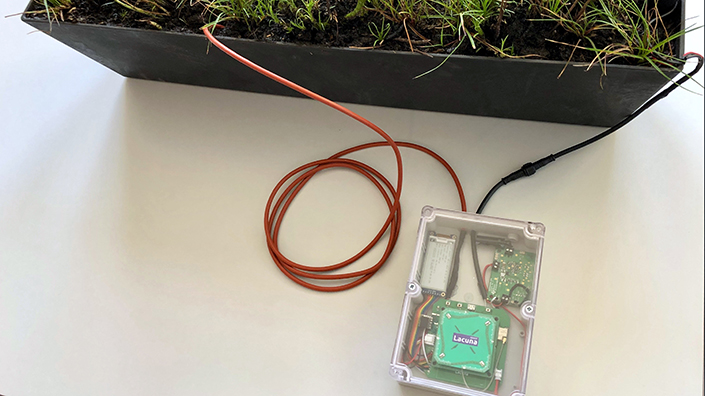Engineering news
Celebrating the success of the “first ever plant-powered sensor”, Plant-e and Lacuna Space said the system could reduce costs, maintenance requirements and environmental impact of Internet of Things (IoT) networks.
The sensor combines energy-harvesting technology from Dutch start-up Plant-e with extremely power-efficient devices from Lacuna Space, based in the Harwell space technology hub in Oxfordshire and the Netherlands. The technology uses submerged anodes and cathodes to harvest ‘carbon-negative’ electricity from living plants and bacteria. The self-sustainable devices operate independently of sunlight.

The plant-powered sensor could revolutionise low-power IoT networks (Credit: Lacuna Space)
Electricity generated by the device transmitted LoRa (long range) messages about air humidity, soil moisture, temperature, cell voltage and electrode potential to a Lacuna Space satellite in orbit. The system could have applications in data gathering from agricultural land, rice fields or other aquatic environments without external energy sources.
“This collaboration shows how effective plant electricity already is at its current state of development," said Plant-e CEO Marjolein Helder. "We hope this inspires others to consider plant electricity as a serious option for powering sensors.”
Lacuna Space is launching a low-Earth-orbit satellite system to provide a global IoT service. The service could allow data collection from sensors in remote areas with little or no connectivity. The company offers a pilot service with one satellite in orbit, and three more satellites will be launched during the next few months.
“This opens up a new era in sustainable satellite communications,” said Rob Spurrett, CEO and co-founder of Lacuna Space. “There are many regions in the world that are difficult to reach, making regular maintenance expensive and the use of solar power impossible. Through this technology we can help people, communities and companies in those regions to improve their lives and businesses.”
The pilot service was supported by the European Space Agency Artes programme.
Want the best engineering stories delivered straight to your inbox? The Professional Engineering newsletter gives you vital updates on the most cutting-edge engineering and exciting new job opportunities. To sign up, click here.
Content published by Professional Engineering does not necessarily represent the views of the Institution of Mechanical Engineers.